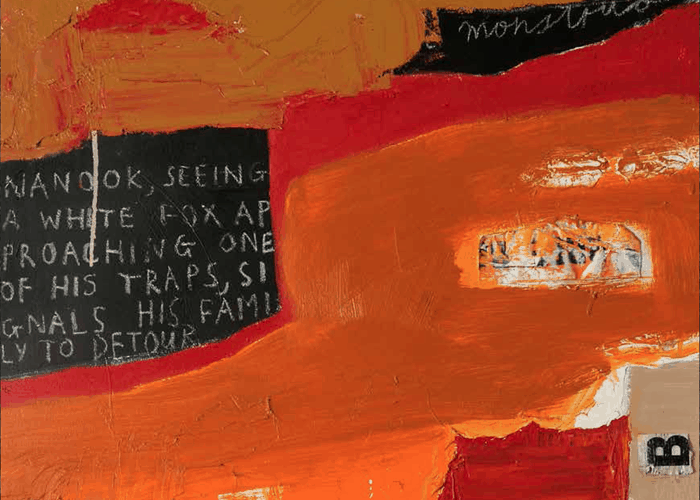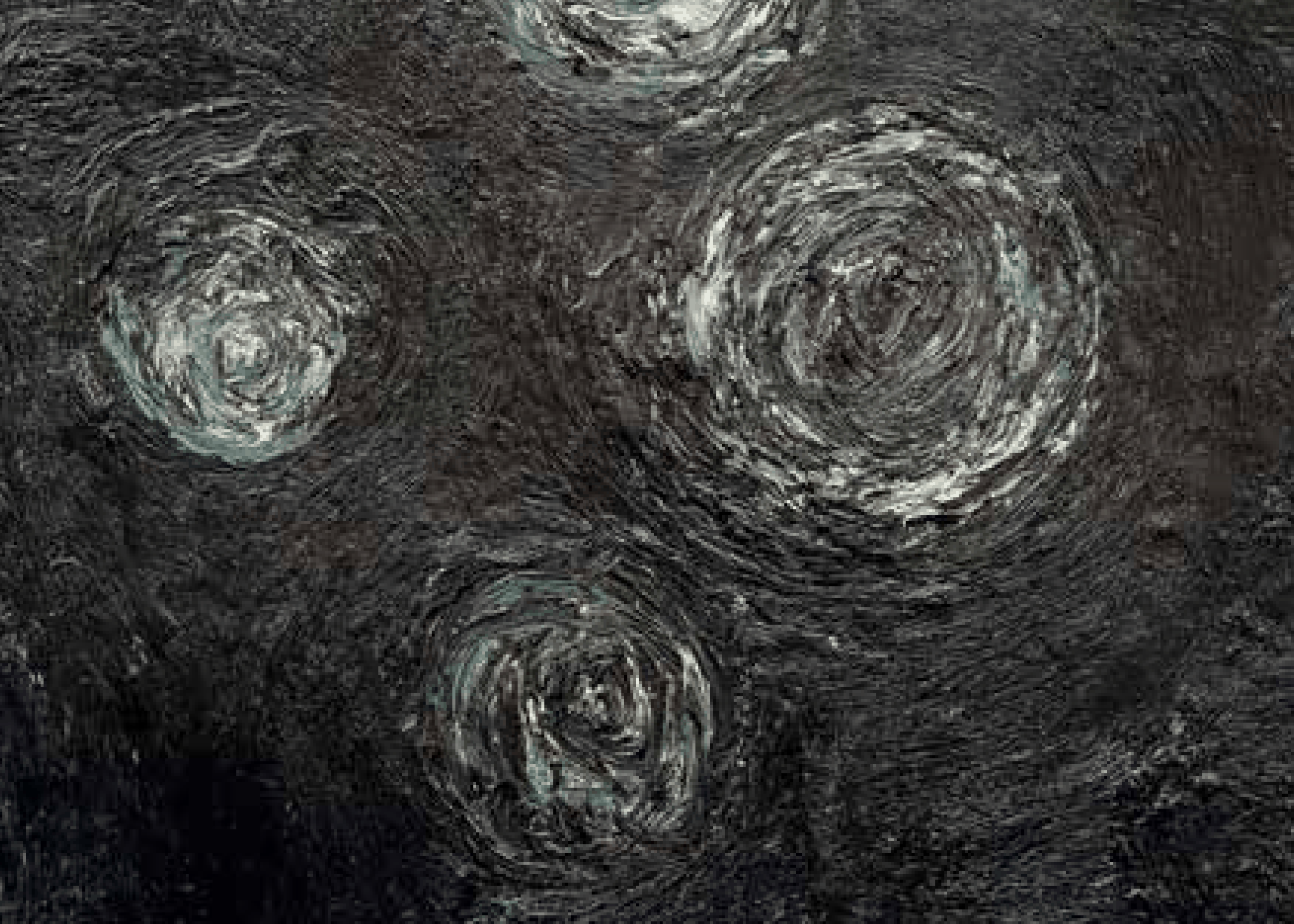
Gerhard Schoeman, There Stood a Splinter of Fig on Your Lip (For Paul Celan), 2013. Oil On Canvas, 84 x 64cm. Courtesy of the artist.
Gerhard Schoeman: I want to begin with a question Hermione Lee asks Philip Roth in an interview in The Paris Review: “How much of a book is in your mind before you start?” Roth responds: “What matters most isn’t there at all. I don’t mean the solutions to problems. I mean the problems themselves. You’re looking, as you begin, for what’s going to resist you. You’re looking for trouble. Sometimes in the beginning uncertainty arises not because the writing is difficult, but because it isn’t difficult enough. Fluency can be a sign that nothing is happening; fluency can actually be my signal to stop, while being in the dark from sentence to sentence is what convinces me to go on.” Can you comment on this?
Ricky Burnett: That’s wonderful.
Elaborate.
Does it need elaborating?
Well no, but how does it relate to your own painting? We often speak about the difficulty of starting. It comes off much better when there is already something there, something resistant.
No it’s absolutely right. If you start where you think you’re going to end, you have a design, or you have a sketch, a little picture in your head. And I guess one doesn’t want to start there. If you are too explicit about that sense you have of a painting, you demean it. You lose it and it becomes too thin. The temptation to be satisfied with some first pass on the canvas — it’s got to be resisted; it just has to be resisted. And the point is, as it starts to move towards where you thought it was going to go, you’ll slip, hopefully. Because when you do, a slightly new configuration, something that is embedded in there, has a chance to appear — almost of its own accord. Something is revealed in the experience.
Say something more about something appearing as if on its own accord. This fascinates me. Michael Fried quotes Wittgenstein in the chapter on Jeff Wall in his book Why Photography Matters as Art as Never Before. Wittgenstein alludes to happening upon someone or something, as though the curtain rises, but there isn’t a stage, and you see “it” as if of its own accord. And then that is the authentic thing because there is no playacting: “and one leaves it the way it is.” Perhaps that is what you’re saying about painting, that you come upon something that is becoming itself.
Which is why in moving the material around and getting lost in it, it fights you back, and so on, there’s a kind of openness and closedness that comes your way. It’s very different from having a project and plotting it out.
Yes, that is the trouble with art and theory produced in academic institutions. There is simply too much formula. Easily recognizable, ready-made ideas about gender constructs and the political body, pandered around the classrooms and art studios by unimaginative academics. Tired clichés. The system feeds off itself. The art, which is more like social science, is packaged and thin. The life has been sucked out of it and it can no longer come into being of its own accord. It is pre-ordained. To quote Frank Auerbach: “To work on a pre- ordained armature is a sine quo non of second- rate painting.”
It’s very much like saying “I’ve got an inclination,” and then you start to see how that inclination inches into the material, and the material resists it and throws it back at you, you cock-up a bit here and there, and in the materials (if you’re alert to it, you do need to practice at it, maybe for years) you notice a little chink that will come up.
Let’s return to our shared abhorrence of academic strategising, the writing of proposals in order to get funding from the university. In these proposals, academics lay out exactly what they’re going to do. This seems to me completely antithetical to what you’re talking about. You cannot outline what you’re going to do in a painting, if what one is trying to do is to represent something raw. Students are forced to do this kind of endless self-explaining and it’s self-defeating. You’re producing art which has been talked to death.
I’ve had students who have come to me, having graduated from places like Unisa, where there is a sort of social sciences paradigm that says: “Tell me your research or experimental model, layout your hypothesis.” Then if you don’t live up to the original proposal it’s like you’ve broken contract. For me, every painting is like breaking a contract.

I want to read two quotations that to me seem to resonate deeply with what we’re discussing. The first is by Frank Auerbach, who you regard to be a fundamentally important painter today, as you do with Cézanne who you say thinks in his paintings, that you can watch him think inside of his world. The same could be said of Auerbach, who says, “I don’t visualise a picture when I start. I visualise a piece of recalcitrant fact and I have a hope of an unvisualised picture which will surprise me out of my concentration with this fact.” He adds: “This recalcitrant, inescapable ‘thereness’ of what I call everyday objects, which to people with an imagination seem about the most amazing thing.” The late great critic Robert Hughes picks up on Auerbach’s materiality, his delving into things as he delves into paint. He wrote: “Paint would always be the first thing one saw.” We have a shared love for the materiality of paint, for pushing it around, as we do for the materiality of words, which one also has to push around, take trouble over. I think of the writer Don DeLillo who observed that he preferred typing on a typewriter to writing on a word processer, because he liked to look at the letters stamped into the paper.
Just clarify for me, is Auerbach talking about painting or ‘objectness’ when he speaks of recalcitrance?
Both. This recalcitrant fact in the world is the subject of the painting, which in turns becomes a recalcitrant fact.
Suppose one of my students was painting a teacup. The teacup would be a recalcitrant object. In terms of her painting, recalcitrance would be a measure of its success
Yes. Let me refer you to the great painting by Chardin of a woman drinking tea. We see her profile. She is perfectly still. Fried would say she is absorbed. But in her being there and yet also being elusive, she becomes recalcitrant, and, of course, so does the painting.
So learning to paint is like growing objects. You’re nurturing all the time, rather than willing or insisting.
Sure. Although, you also talk about intentionality, another favourite subject of Fried’s. The artist’s ego involved in the making of the work.
The question then is what is the ontological nature of the object that you’re growing? Because at the end of the day it is a psychic mirror, isn’t it? You’re embedding into it. Will gets embedded and so does intention. The painting is a thick object, with skin, where the brain and the body meet.
The notion of ‘medium’ and its self-criticality has become debased. Postmodernist advocates for the ‘post-medium’ scoff at the idea of painting-for-itself but that ship has sailed. What are your thoughts on medium — door, vehicle, presence of absence, whirlpool?
Good painting is a hymn to the lone, the solo and the alone; it’s about immersion not dispersion. Oil paint is still our best analogy for skin — to be in skin, to be wrinkled, to be fresh, to be shining, blotched or diseased or even translucent. A painting itself is a skin, a surface tension of ripples and coagulations, of cautions and extravagances. Why wouldn’t the paint be the best way to engage with it? How else would you read a poem except by the textures, layers and tensions of language ?
You are currently working on a suite of paintings based on Goya’s Disparates and you are immersed in “the structure of light and dark.” How do you relate to Goya’s complex and fraught ridicule of humans as asses and the world as upside down?
I think of these paintings as ‘adaptations.’ I have this crazy idea that it might be possible to arrive at the theatre without the props, to arrive at a flavour, at nuanced implications, without listing the ingredients, without the body parts, the beasts and the farts. So yes, I’m very engaged with their structure. As for politics, Goya’s strengths lie in his flavours — an acute sense of disappointment, a generalized disgruntlement, distaste for piety — and not his assertions. His structure is defined by world-weariness and not politics. He inverts; he doesn’t advocate.
Any thoughts on painting in South Africa today?
I don’t see enough painting here, especially not the hard-won, discovered sort; the sort of painting that emerges from process and not programme. There’s just not enough.
Gerhard Schoeman is an art historian, writer, critic, and artist based in Johannesburg. He is currently completing his first novel titled By The Time I Get Back.
Ricky Burnett is a painter and teacher of painting, currently working on a series of paintings based on Goya’s Disparates. His most recent exhibition was ‘Damascus Gate.’ In the 1980s he curated the groundbreaking exhibition ‘Tributaries.’



